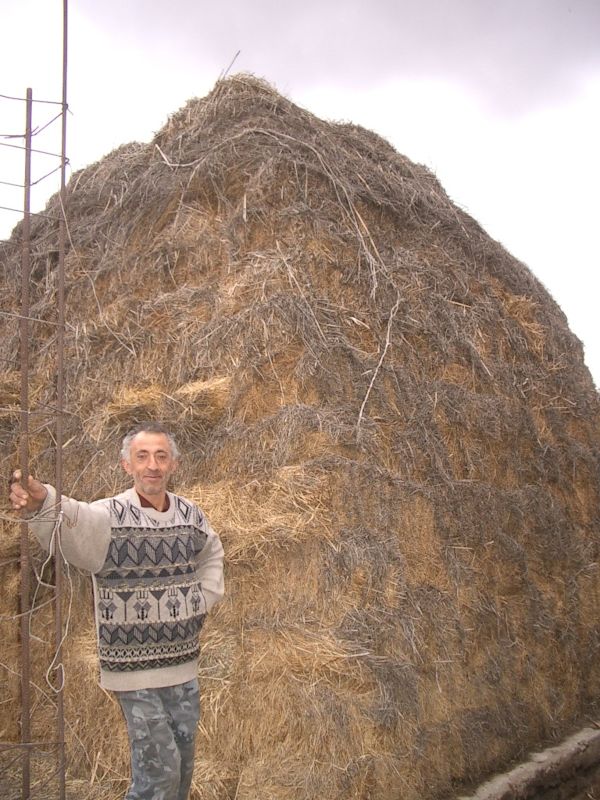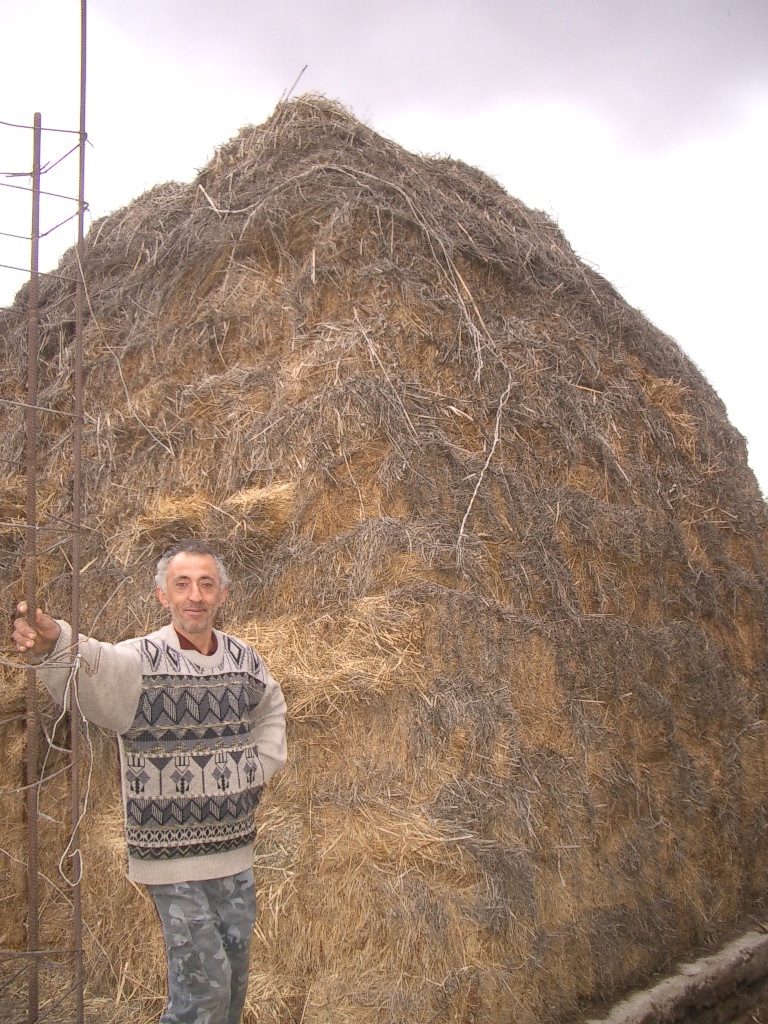
By Brian Kelly, KF9, Armenia
Not very good, at least in some of these Armenian villages I’ve been dropping in on lately. Have you smelled a chicken coop, or a sty filled with 20 pigs lately? It’s tough to carry a conversation in there. Visiting borrowers, at least in Armenian villages is quite the sensory overload. You will smell more than you hoped to, probably taste something you never expected to, and perhaps hear a story that will inspire you to start your own apricot grove.

Haaaayyyy. This will feed the animals throughout the winter, looks tasty
Kiva does an interesting thing. It helps put stories to the often boringly academic discipline of microfinance. Without the stories, Kiva would struggle to fund loans as quickly as it does. They help to strike a chord inside of us that increases willingness to lend or donate because of a connection felt on a human level. But you probably know all of that already, (or have read some of the chatter) and this spiel sounds all good and nice, but what does a loan really LOOK like. What does it feel like, taste like up close? How is access to credit really affecting the borrower? Well that question is one of the unique opportunities that Kiva Fellows get to ask and hopefully attempt to answer.
A microloan morphs into something much more visceral when you are trudging through a muddy sty and meeting a 200 pound pig, dodging frenetic chickens scrambling from their pen, or stepping over a field of manure that smells something awful. When the borrower pulls a carrot out of the ground after 10 minutes trying to explain what the hell he grows, and I exclaim, “ohhhhh a carrot!!” the cerebral statistics and studies of microfinance start to fade away. Shaking this man’s weathered hands and seeing his big smile when talking about his business, it feels more like carrot growing 101. He goes on to describe his hopes to start his own stand at the market, so he doesn’t have to rely on other re-sellers. And with this view, these sights, sounds, and smells of someone’s livelihood, you start to forget about terms like “loan” or “zero percent capital” as you become more immersed in their everyday operations. You see that these borrowers are tirelessly working to improve their business however they can, and it just so happens that a “microloan” is the means to get it done. Sometimes I feel sheepishly western when asking credit officers or employees about “microfinance,” because here it doesn’t necessarily feel like that magical poverty-fighting tool I learned about in school. Instead, I simply see a means of improving businesses that wouldn’t otherwise exist in Armenia. And you start to witness the tangible improvements borrowers have made in their business, and hear about everything that wasn’t here ten years ago. Smiling faces, unanimous thank yous to the MFI and the universal phrase: “I simply couldn’t be here without the MFI, there is just no way any of this would be possible. Everything here, (pointing across farmland that stretches to Turkey) is because of my loans….”
Visit after visit, I keep becoming aware of the “human factor” that has proved to be absolutely paramount to microfinance in Armenia. Whether its spotting the nuances in how the borrower values her family, or a group’s good standing within their thousand person community, to how a villager might dress when applying for a loan, these all affect the ability to get credit as much as any chart-topping FICO score would. The credit officers relentlessly make themselves available to answer their client’s needs in villages as far as 50 kilometers away, because there is no other way to do business other than face to face sometimes. When making these visits, the drams and dollars start to fade away and you realize that this is all about relationships, and that the success of these businesses is hinged upon them. Becoming aware of this human factor and the sights and sounds of a borrower’s business helps us to learn more about them, and I am willing to bet there is a direct correlation between the amount of human interaction I had learning about a borrower and the time I spend scraping pig crap off my shoes at the end of the day. The loan fades into this ancillary construct of threshold maximums, amortization tables, and repayment dates. Instead I see a rack of clothes imported from Dubai to increase a shop owner’s Fall line, an extra acre of farmland to diversify into livestock on top of the grape-growing business, a new shop at the corner of a busy intersection instead of selling floral arrangements out of the home, or the marked-off space where expensive equipment will be installed to build out a new chicken coop. And these sensory experiences, often in the form of some less-than-pleasant smells, provide a perspective that can’t be found in the head branch office of an MFI or an academic journal debating small-scale credit’s effectiveness. These visits have taken on all of the sensory characteristics that something that the word “loan” can never quite encapsulate. You start to smell the business, feel the weathered hands of the hardworking farmer, and sometimes taste the freshness of the produce that is shoved into your bag by the notorious Armenian hospitality.

This man could have talked about carrots all day long
Now, I’ve tried to be wary of the fact that I may be viewed as the foreigner representing $$$ from far-away lands that one must smile and do a little success-story song and dance for. OK, so lets play the role of the skeptic and assume the loan officers only take me to their most successful clients. Suppose there are “bad clients” that I’m not being shown, or mediocre clients even who are just scraping by. If this were the case, then where would the incentives be for the MFI to keep operating in the region? We have to assume that these clients would present a financial burden on the MFI that when scaled up across 20,000 clients would not make running a business in this market lucrative in any way. And in the case of an MFI operating as a for-profit, central-bank regulated entity like the one I’ve been seeing, delinquent loans would be too costly to the business. Margins are thin in microfinance, so without successful borrowers, MFIs don’t stay afloat. So while I may be toured around and shown the crème de la crème (and I’ve tried to tease out examples of late payers or failed businesses) I am confident that the sample of clients I have seen really does prove encouraging progress here in Armenia. And at the least, these top 10% success stories provide encouragement and a precedent for the rest of their village or greater community that there is hope to break through this otherwise grim economic environment. And to put it as eloquently as possible, I think that is most awesome.
As a Kiva Fellow who has been lucky enough to see these borrowers and loans firsthand, it really has put “microfinance in Armenia” in perspective. Statistics turn into stories and you forget about questions like “does microfinance really work?” and “why are interest rates so high?” as well as all of the other academic jargon that comes along with development. Instead, the human side continually reemerges as the defining thread of each borrower visit. And maybe the need for stories and descriptions is a human weakness on our behalf as lenders, but it still doesn’t disregard the fact that these businesses are expanding, consistently graduating to higher loan amounts and taking pride in the fact that they don’t have late payments. So if stories help expand access to improving businesses in places like Armenia, then I’m all for them.
An example of a client making Lavash, the delicious bread of Armenia, in her home oven:
'Brian Kelly is a member of KF9 serving his Kiva Fellowship in Armenia to help bring pilot partner Aregak UCO onto the Kiva website. To join the Armenian lending team, click here. And to see more about Armenian loans, check out Nor Horizon UCO, and click here for fundraising loans (you may have to come back as they are new too)
/>PREVIOUS ARTICLE
Spreading the word: MFIs and Publicity →NEXT ARTICLE
US Embassy Alerts a.k.a. Things to Worry About →













